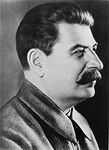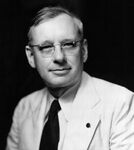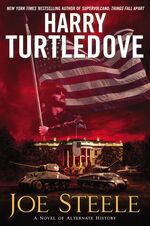| ||||||||||||||||||||||||||||
| ||||||||||||||||||||||||||||
| ||||||||||||||||||||||||||||
The United States presidential election of 1936 was the 38th quadrennial presidential election, held on Tuesday, November 3, 1936. It proved to be one of the most lop-sided elections in the country's history, as incumbent President Joe Steele defeated Kansas governor Alf Landon.
The Campaign[]
Incumbent President Joe Steele had gained substantial support with his response to the Great Depression, the Four Year Plan. Moreover, Steele's ability to find traitors to the country within some of its highest offices began to quell some of his critics. The most dramatic of these was the arrest, trial, and execution of the so-called "Supreme Court Four", four Supreme Court justices who had routinely ruled Four-Year Plan legislation as unconstitutional. The Four had confessed in their military trial that they had sought to thwart Steele.[1]
On the Republican side, former president Herbert Hoover attempted to gain the nomination, but it went to Alf Landon instead. Frank Knox was chosen as his running mate. Landon had initially tried to present himself as the true populist in the race, reminding the country that Kansas had been home to the first Populists. However, that appeal was quickly drowned out when journalist and Steele-supporter Charlie Sullivan, used the definition of populist Ambrose Bierce created in The Devil's Dictionary: "A fossil patriot of the early agricultural period, found in the old red soapstone underlying Kansas; characterized by an uncommon spread of ear, which some naturalists contend gave him the power of flight, though Professors Morse and Whitney, pursuing independent lines of thought, have ingeniously pointed out that had he possessed it he would have gone elsewhere. In the picturesque speech of his period, some fragments of which have come down to us, he was known as 'The Matter with Kansas.'" In short order, Landon was dubbed "the Matter with Kansas" by the Steele campaign. Landon unsuccessfully tried to turn the name around, claiming that if he were the Matter with Kansas, Steele was the matter the whole country.[2]
Infamously, Literary Digest predicted Landon would win twice as many electoral votes as Steele.[3]
The Election[]
While Steele was giving the country a taste of the terror he would unleash in later years, the Four Year Plan was popular, and Landon could never quite overcome the image of being "the Matter with Kansas". Steele rode this mixture of practical results and lackluster performance from Landon to a substantial victory. Landon was able to capture the eight electoral votes from the two states of Maine and Vermont, but the remaining 46 states voted for Steele and gave him 523 electoral votes.[4]
Literary comment[]
While the short story depicts the election in broader strokes, but the result is the same, with Landon carrying only Maine and Vermont.
OTL Election[]
The OTL 1936 elections results were exactly the same as in the novel, but with Franklin D. Roosevelt in place of Joe Steele.
Ironically, prior to the election, the Republicans had been expecting a landslide for Landon, due to a badly out-of-touch poll conducted by Literary Digest magazine (an incident referenced in Joe Steele). Literary Digest had correctly predicted the last 5 elections. However, the magazine didn't consider the fact that the majority of its subscribers were Republican, and so more likely to vote for Landon.
See Also[]
References[]
- ↑ Joe Steele, pg. 105.
- ↑ Ibid., pgs. 134-136.
- ↑ Ibid., pg. 137.
- ↑ Ibid., pg. 137.
| |||||||||||||||||||
| |||||||||||||



